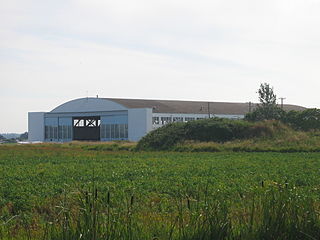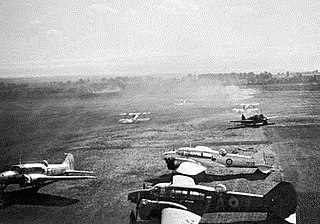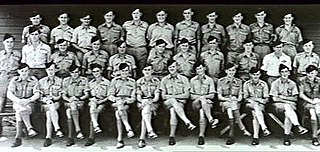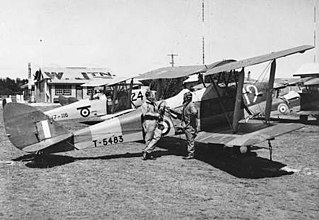
Canadian Forces Station Ladner is a former military airfield and communications station located beside Boundary Bay and 2.5 nautical miles east of Ladner in Delta, British Columbia, Canada, south of Vancouver and close to the U.S. border. After its closure it was reopened as Boundary Bay Airport.

No. 452 Squadron is a Royal Australian Air Force (RAAF) air traffic control unit. It was established in 1941 as a fighter squadron, in accordance with Article XV of the Empire Air Training Scheme during World War II. The squadron flew Supermarine Spitfires for the entire war, initially over the United Kingdom and Nazi-occupied Europe. It was later based in Australia and the Netherlands East Indies, before being disbanded in 1945. It was re-raised in its current role in February 2011.

No. 5 Operational Training Unit was an operational training unit (OTU) of the Royal Australian Air Force. It was formed at Wagga Wagga, New South Wales, in October 1942 to train pilots and navigators for service in World War II. The unit was initially equipped with Bristol Beauforts and Beaufighters, and later received Douglas Bostons and de Havilland Mosquitos, among other types. No. 5 OTU was transferred to Tocumwal in October 1943, and then to Williamtown in mid-1944. It was reorganised as a fighter conversion unit flying P-51 Mustangs and CAC Wirraways in February 1946, and disbanded in July 1947.

RAF Tealing is a former Royal Air Force station

Royal Air Force Sutton Bridge or more simply RAF Sutton Bridge is a former Royal Air Force station found next to the village of Sutton Bridge in the south-east of Lincolnshire. The airfield was to the south of the current A17, and east of the River Nene, next to Walpole in Norfolk.
RAAF Station Parkes was a Royal Australian Air Force (RAAF) station located at Parkes, New South Wales, Australia. Formed in 1941 as part of the Empire Air Training Scheme as a training station during the Second World War. After the conclusion of hostilities, the training units ceased to operate from the station. No. 87 Squadron briefly operated from the airfield at the station from October 1945 until it was disbanded on 24 July 1946. The station closed in 1946.

No. 5 Elementary Flying Training School was a Royal Australian Air Force (RAAF) pilot training unit that operated during World War II. It was one of twelve elementary flying training schools employed by the RAAF to provide introductory flight instruction to new pilots as part of Australia's contribution to the Empire Air Training Scheme. No. 5 EFTS was established in June 1940 at Narromine, New South Wales, and primarily operated Tiger Moths. It ceased training in June 1944, after more than 3,700 students had passed through.

No. 7 Service Flying Training School was a flying training school of the Royal Australian Air Force (RAAF) during World War II. It was formed in June 1941, and commenced flying the following month. Responsible for intermediate and advanced instruction of pilots under the Empire Air Training Scheme (EATS), the school was based at RAAF Station Deniliquin, New South Wales, and operated CAC Wirraway single-engined trainers. The Wirraways were classed as reserve aircraft for Australia's defence in response to the outbreak of the Pacific War in December 1941. Having graduated over 2,000 pilots, the school was renamed the Advanced Flying and Refresher Unit (AFRU) in December 1944. AFRU was disbanded in May 1946.

No. 2 Service Flying Training School was a flying training school of the Royal Australian Air Force (RAAF) that operated during World War II. It was formed in July 1940, under the command of Wing Commander Frederick Scherger. Responsible for intermediate and advanced instruction of pilots under the Empire Air Training Scheme (EATS), the school was based at RAAF Station Forest Hill near Wagga Wagga, New South Wales, and operated CAC Wirraway and Avro Anson aircraft. The Ansons were phased out in July 1941, and the school became an all-Wirraway unit. In 1942 the RAAF divided the personnel and equipment of No. 2 SFTS between Nos. 5 and 7 Service Flying Training Schools at Uranquinty and Deniliquin, respectively. No. 2 SFTS was disbanded that April, and the base facilities taken over by No. 5 Aircraft Depot.

No. 4 Service Flying Training School was a flying training school of the Royal Australian Air Force (RAAF) during World War II. It was formed in February 1941, and commenced flying the following month. Responsible for intermediate and advanced instruction of pilots under the Empire Air Training Scheme (EATS), the school was based at Geraldton, Western Australia, and operated Avro Anson aircraft. Two reserve squadrons were formed in response to the outbreak of war in the Pacific, though they never saw action. Flying activity was reduced towards the end of 1943, and the school was disbanded in May 1945, having graduated over 1,000 pilots. It re-formed as No. 87 Operational Base Unit, which was renamed Care and Maintenance Unit (CMU) Geraldton in May 1946. CMU Geraldton was disbanded in September 1947.

No. 6 Service Flying Training School was a flying training school of the Royal Australian Air Force (RAAF) during World War II. It was formed in August 1941, and commenced flying the following month. Responsible for intermediate and advanced instruction of pilots under the Empire Air Training Scheme (EATS), the school was based at RAAF Station Mallala, South Australia, and operated Avro Anson and Airspeed Oxford aircraft. The school formed a reserve squadron for Australia's defence after the outbreak of war in the Pacific in December 1941. Having graduated over 2,000 pilots, No. 6 SFTS completed its final training course in September 1945, and was re-formed as Care and Maintenance Unit Mallala in January 1946.

No. 7 Elementary Flying Training School was a Royal Australian Air Force (RAAF) pilot training unit that operated during World War II. It was established in August 1940 at Western Junction Aerodrome, Tasmania, and provided introductory flying training to new RAAF pilots. Training activities ceased in December 1944, and the unit was disbanded in August the next year.

No. 1 Elementary Flying Training School was a Royal Australian Air Force (RAAF) pilot training unit that operated during World War II. It was one of twelve elementary flying training schools employed by the RAAF to provide introductory flight instruction to new pilots as part of Australia's contribution to the Empire Air Training Scheme. The unit was established in November 1939 as No. 2 Flying Training School at Melbourne, Victoria. It was relocated to Parafield, South Australia, in December 1939 and renamed No. 1 EFTS the following month. Training activities relocated to Tamworth, New South Wales, in May 1944; the school was disbanded in December that year.

No. 8 Service Flying Training School was a flying training school of the Royal Australian Air Force (RAAF) that operated during World War II. It was formed in December 1941, and graduated its first course in March 1942. Responsible for intermediate and advanced instruction of pilots under the Empire Air Training Scheme (EATS), the school was based at RAAF Station Bundaberg, Queensland, and operated Avro Anson aircraft. It spawned two maritime patrol squadrons in early 1943, raised in response to increased Japanese submarine activity off Australia's east coast. Some of the school's aircraft were also attached to the Australian Army in 1944–45. No. 8 SFTS completed its final training course in December 1944, and was disbanded in July 1945.

No. 3 Elementary Flying Training School was a Royal Australian Air Force (RAAF) pilot training unit that operated during World War II. It was one of twelve elementary flying training schools employed by the RAAF to provide introductory flight instruction to new pilots as part of Australia's contribution to the Empire Air Training Scheme. No. 3 EFTS was established in January 1940 at Essendon, Victoria, and initially included a significant proportion of civilian staff and private aircraft; by mid-year these had been largely integrated into the military. The school was disbanded in May 1942, its aircraft and instructional staff having been transferred to No. 11 Elementary Flying School at Benalla.

No. 11 Elementary Flying Training School was a Royal Australian Air Force (RAAF) pilot training unit that operated during World War II. It was one of twelve elementary flying training schools employed by the RAAF to provide introductory flight instruction to new pilots as part of Australia's contribution to the Empire Air Training Scheme. No. 11 EFTS was established in June 1941 at Benalla, Victoria, and operated Tiger Moths and Wackett Trainers during the war. It ceased training in July 1945 after almost 3,000 students had passed through, and was re-formed as Care and Maintenance Unit (CMU) Benalla in February 1946. CMU Benalla was disbanded in October 1948.

No. 2 Elementary Flying Training School was a Royal Australian Air Force (RAAF) pilot training unit that operated during World War II. It was one of twelve elementary flying training schools employed by the RAAF to provide introductory flight instruction to new pilots as part of Australia's contribution to the Empire Air Training Scheme. No. 2 EFTS was established in November 1939 as No. 3 Flying Training School at Archerfield, Queensland, and partially utilised aircraft and facilities of the civilian air training organisations based there. The school was renamed No. 2 EFTS in January 1940. It was disbanded in March 1942, and its operations transferred to No. 5 Elementary Flying School at Narromine, New South Wales, and No. 11 Elementary Flying School at Benalla, Victoria.

No. 8 Elementary Flying Training School was a Royal Australian Air Force (RAAF) pilot training unit that operated during World War II. It was one of twelve elementary flying training schools employed by the RAAF to provide introductory flight instruction to new pilots as part of Australia's contribution to the Empire Air Training Scheme. No. 8 EFTS was established in September 1940 at Narrandera, New South Wales. Training ceased in December 1944 and the school was reduced to maintaining base infrastructure and aircraft. It was officially disbanded in June 1945 and renamed Care and Maintenance Unit (CMU) Narrandera. The CMU was disbanded in December 1947.

















